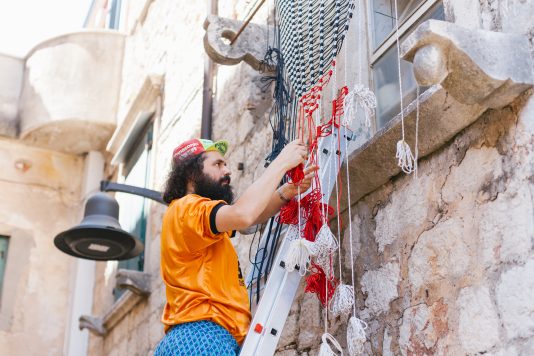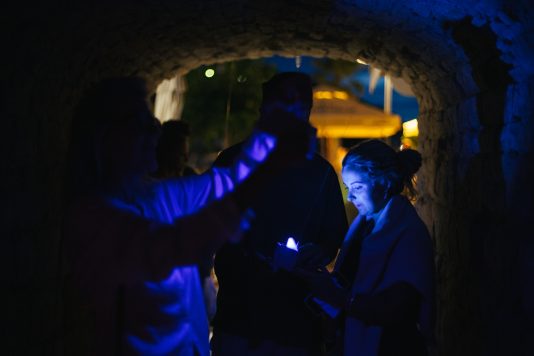“Songs of the Singing Stones, Salty Salads, and Seasonal Sailors”
Embarking on an exploration of a new place is an ever-surprising journey, revealing its intricacies, humours, idiosyncrasies, and occasional annoyances. Even more astonishing are the rediscoveries and entirely new findings in places you’ve been exploring for years. Jelsa’s myriad dimensions continue to astonish, enchant, and at times, dismay me — the various ways the town harmonises with the sea and the multitude of people passing through every summer. It’s a place where the chaos of the summer season converges with the backstage, with alleys still belonging to the locals, all within a setting filled to the brim with a cornucopia of seasonal goods and consumables.
This year’s Magic Carpets residencies were seamlessly integrated into the program of Jelsa Art Biennial 2023 (JAB23), under its overarching concept “Decubator”. The curatorial text by LAB852 expresses the intention: “While authors like Mark Fisher argue that capitalism makes it impossible to imagine a future different from the existing system, and the world provides dystopian forecasts that seem inevitable, we seek to encourage the process of de-thinking such scenarios — a practice that requires patience and questioning, while simultaneously offering alternative solutions. In the 2023 edition, we are looking for opportunities to change the established patterns of thinking and communicating in the dominant developmental narrative, while encouraging decubation, as opposed to incubation, in discovering the intertwining relationships and processes within the micro and macro systems of the island’s biosphere.”
The concept of the urban element, a street as a backstage, and the thematic backbone of the biennial placed all the interventions, happenings, installations, and performances of JAB23 in the condensed territory of a Dalmatian kala, a street in the grid of the Mediterranean city. In the context of the typical present of a Dalmatian town, kala offers space for intimacy and rest in contrast to constant “moving,” allowing encounters with oneself as opposed to mass tourism.
To set the scene for the residencies, we invited a group of researchers from the fields of ethnology, cultural anthropology, and architecture — The Anatomy of the Islands — to conduct research among locals living in kala. This served as a model for observing the coexistence of members of the local community within the linear architectural space of a typical Dalmatian street. Understanding the rhythm of life in one of Jelsa’s streets reflects the same rhythm of life across the entire island, which the Anatomy researchers took as a topic while considering the possibilities of space transformation and the future of the community. The gathered insights served as the starting point for artists in residence, leading to the reinterpretation of old stories, legends, and recipes of Jelsa into a series of activities, performances, and concepts that stretch through the street.
Buže
Artist: Željko Beljan
While strolling along kala for the first time, one can easily fall into a dazed state of saturated senses — from signs pointing to museums or restaurants, through changing spots of shadow and sunlight on stone textures, to capers growing nonchalantly from the cracks in walls. And there, among the layers of architecture and life, every now and then – buža. Buže, known as “ears of windows” on some islands or probužoni kamik (perforated stone) in the dialect of Hvar, are stone protrusions with a circular hole in the middle, usually located at the height of two-thirds of the window frame. It is assumed, because buže mostly live in pairs, that a beam was passed through them, but their function is the subject of various theories: that they were used for drying clothes, or coloured Venetian cloths, animal skins and furs, hanging wet and damp sheets, as protection from the sun and “air conditioning” of the living spaces, as well as for placing festive flags, tapestries, and cloths with family coats of arms during important celebrations. What is certain is the multitude of personal truths and stories of the people to whom they belong and who live with them every day. It is precisely this openness in interpretation that gives a wide space for play. With this site-specific installation in the kala of Jelsa, Željko Beljan brings buže to life, following their historic connections with textile, with a simple gesture “reminding” visitors of their existence and inviting further intertwined interpretations.
Tunnel – dethinking
Artists: Francisca Rocha Gonçalves, Vana Gaćina, Luana Lojić, Anica Lora Nižić, Helena Rubčić
Tunnel – dethinking brought together a group of artists with diverse backgrounds in a series of site-specific collaborative interventions in the public space inspired by Jelsa’s life, rhythms, and atmospheres. Placed in the passage (tunnel) between the waterfront and the street, the residents used this space to work and present visions of different potentials of a public passage, to create new dynamics of the space, and enhance meaning of interactions: meeting place, cinema, recital stage, party venue, etc.
Imagining Gardens
Artists: Anja Leko, Andrej Beštak, and Paula Płavniece
Collaborating Artists: Dora Brkarić, Hugo Baranger, Robert Fenrich, Rebecca Merlic
Imagining Gardens is a contemporary opera production, curated by Anja Leko, Andrej Beštak from Croatia, and Paula Płavniece from Latvia, presented as a moving performative piece spanning the entirety of kala, in collaboration with the local choir of St. Cecilia participating as performers (3 adult soloists and 10 children). The anchor point of the performance is the research by Anatomy of Islands, who explored the lives of locals living in a narrow street in Jelsa called kala, and whose gardens, usually closed off to the public, took the centre stage as the setup for the performance. The piece was expanded on and elaborated during a residency in Jelsa, with the usage of different practices and tools (AI algorithms, dance, singing, video mapping). Imagining Gardens is a journey through the hidden, shaded part of Jelsa, rediscovering near-forgotten ancient knowledge and perceiving the growth and renewal of animal and plant matter as a portal to an alternate reality.
“There’s an irresistible allure about hidden places. Perhaps it’s the mystery, the sense of the unknown that draws us in. Or maybe it’s the feeling of exclusivity, the sense that we are accessing something that others cannot. A reminder that there is always more to discover, more to learn, more to experience. And in that reminder lies the true allure of hidden places: the promise of a world that is vast, complex, and endlessly fascinating, just waiting to be explored. Gazing at the tops of palm trees or the ivy leaves that have found their way through the cracks triggers our curiosity and the urge to peek inside.
The Garden represents nature, but it also embodies a set of controlled conditions for plants to grow. It is taken care of, nourished, and selected with the idea of development and the purpose of keeping human existence alive. It is a meeting point of nature and technology. The garden offers a conscious decision of what to keep and what to leave behind. A constant transformation of existing forms in order to accumulate new ones, a continuous mutation of species to the point of non-recognition. It shows us the ever-moving world and its traditions and constantly challenges us with the question of what information we want to preserve.”
Curatorial text by Marija Kamber
















